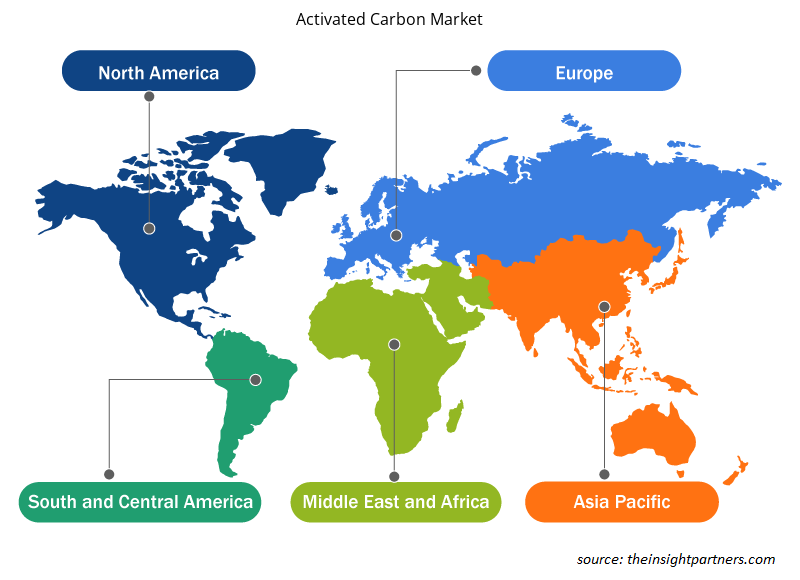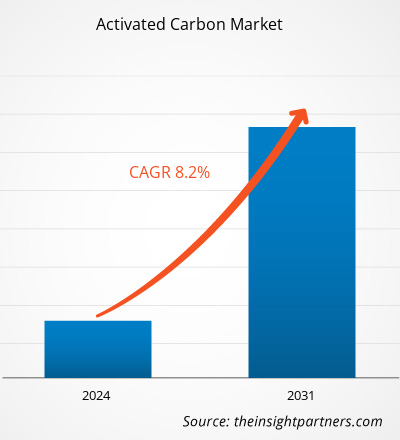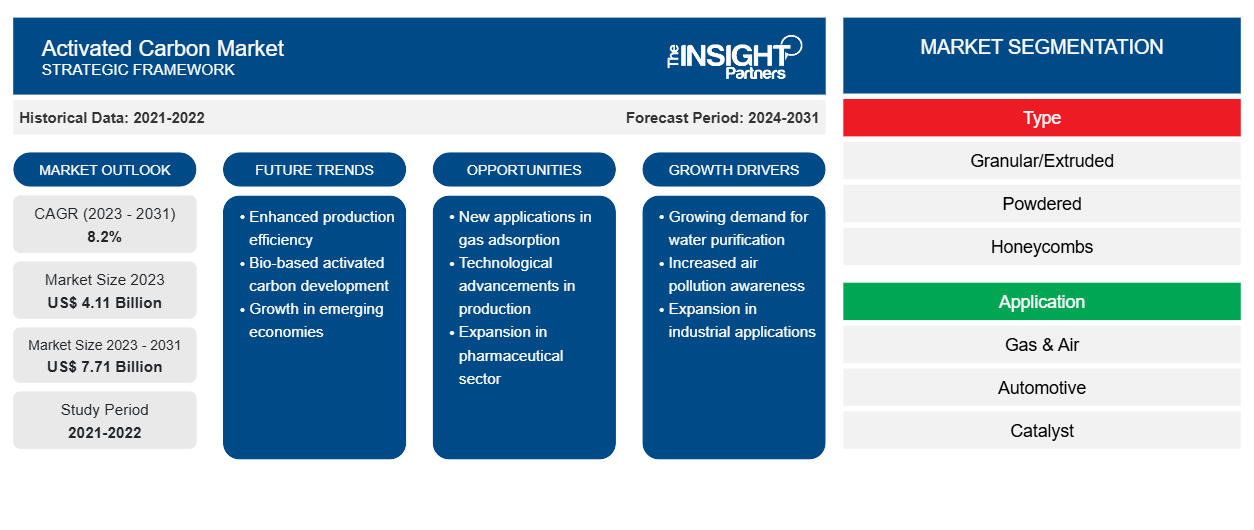Si prevede che la dimensione del mercato del carbone attivo raggiungerà i 7,71 miliardi di dollari entro il 2031, rispetto ai 4,11 miliardi di dollari del 2023. Si prevede che il mercato registrerà un CAGR dell'8,2% nel 2023-2031.
È probabile che la crescente attenzione dei produttori allo sviluppo di carbone attivo da fonti biologiche e scarti agricoli, in risposta all'attenzione globale per lo sviluppo sostenibile e le economie circolari, rimanga una delle tendenze chiave del mercato del carbone attivo.
Analisi del mercato del carbone attivo
La crescente adozione di carbone attivo per il trattamento delle acque reflue sta alimentando la domanda di carbone attivo. Negli ultimi due decenni, la domanda di trattamento delle acque reflue è aumentata a causa della tendenza a recuperare l'acqua dai processi di generazione di energia. I governi di Stati Uniti, Germania, Thailandia, Filippine, Cina e India hanno avviato programmi e iniziative per supportare il trattamento delle acque reflue e l'economia circolare attraverso autorità statutarie o legislative. Secondo il rapporto dell'Agenzia per la protezione ambientale degli Stati Uniti pubblicato nel 2022, circa 128,7 miliardi di litri di acque reflue vengono trattati negli impianti di trattamento delle acque reflue negli Stati Uniti. Il rapporto rivela anche che il 20% delle famiglie statunitensi utilizza fosse settiche e sistemi per il trattamento delle acque reflue locali.
Panoramica del mercato del carbone attivo
Il carbone attivo viene prodotto in forme distinte per soddisfare applicazioni specifiche di vari settori di utilizzo finale come la purificazione di aria e gas, il trattamento delle acque reflue, i prodotti chimici e gli alimenti e le bevande, tra gli altri. Le forme disponibili di carbone attivo includono polvere, pellet, estrusi, granuli, struttura a nido d'ape, impregnati e riattivati. La forma granulare di carbone attivo è ampiamente utilizzata negli impianti di trattamento delle acque, mentre il carbone attivo in polvere è utilizzato nell'industria alimentare e delle bevande per varie applicazioni come la purificazione e la raffinazione. Le elevate capacità di adsorbimento del carbone attivo lo rendono un'opzione adatta per l'estrazione dell'oro dalla miscela oro-cianuro. Inoltre, il trattamento delle acque è uno dei principali segmenti di applicazione per il carbone attivo. Il carbone attivo è anche ampiamente utilizzato per il trattamento dell'aria industriale in impianti petrolchimici , discariche, operazioni di produzione e impianti di lavorazione chimica per filtrare inquinanti pericolosi come composti organici volatili.
Personalizza questo report in base alle tue esigenze
Riceverai la personalizzazione gratuita di qualsiasi report, comprese parti di questo report, o analisi a livello nazionale, pacchetto dati Excel, oltre a usufruire di grandi offerte e sconti per start-up e università
-
Scopri le principali tendenze di mercato in questo rapporto.Questo campione GRATUITO includerà analisi di dati che spaziano dalle tendenze di mercato alle stime e alle previsioni.
Driver e opportunità del mercato del carbone attivo
Aumento delle normative sulle emissioni di mercurio
Le emissioni di mercurio sono pericolose per l'ambiente e la salute umana e vengono rilasciate dalle centrali elettriche a carbone. Molti paesi hanno stabilito delle normative sulle quantità di tossine rilasciate da queste centrali elettriche. Grazie alla Global Mercury Partnership, le normative e le politiche in diversi paesi sono state intensificate. Tecnologie di controllo avanzate, tra cui hardware e software, vengono applicate per ridurre le emissioni di mercurio. Il carbone attivo è una delle parti più importanti dell'hardware utilizzato in queste tecnologie per filtrare l'aria. Inoltre, il carbone attivo impregnato è stato sviluppato anche aggiungendo altri materiali, come lo zolfo, per controllare in modo efficiente le emissioni di mercurio. Pertanto, la crescente domanda di purificazione dell'aria sta guidando la domanda di carbone attivo nel mondo.
Progresso tecnologico
Sono stati condotti diversi studi di ricerca in tutto il mondo per progettare processi di produzione efficienti per il carbone attivo e sviluppare carbone attivo ad alte prestazioni. Gli scienziati si concentrano sullo sviluppo di tecnologie convenienti, ottimizzate ed efficienti per produrre carbone attivo. Nel 2021, un team di ricerca della Central South University, Changsha, Cina, con il supporto della National Natural Science Foundation of China, ha proposto un piano di ricerca per la preparazione in un unico passaggio di carbone attivo da materie prime a base di carbonio come carbone di bassa qualità e pellet ossidati.
Analisi della segmentazione del rapporto di mercato del carbone attivo
I segmenti chiave che hanno contribuito alla derivazione dell'analisi di mercato del carbone attivo sono tipologia e applicazione.
- In base al tipo, il mercato del carbone attivo è segmentato in granulare/estruso, in polvere, a nido d'ape, impregnato e riattivato. Il segmento in polvere ha detenuto una quota di mercato maggiore nel 2023.
- In termini di applicazione, il mercato è segmentato in gas e aria, automotive, catalizzatori, prodotti chimici, alimenti e bevande, minerario, farmaceutico, trattamento delle acque e altri. Il segmento del trattamento delle acque ha dominato il mercato nel 2023.
Analisi della quota di mercato del carbone attivo per area geografica
L'ambito geografico del rapporto sul mercato del carbone attivo è suddiviso principalmente in sei regioni: Nord America, Europa occidentale, Europa orientale, Asia Pacifico, Medio Oriente e Africa, America meridionale e centrale.
L'Asia Pacifica ha dominato il mercato del carbone attivo. Secondo l'European Chemical Industry Council, la quota della Cina nelle vendite del mercato chimico globale è aumentata al 43,0% nel 2021, rispetto al 28,3% registrato nel 2011. Si prevede che un aumento della richiesta di vari prodotti chimici e un conseguente aumento della produzione stimoleranno la domanda di carbone attivo per la purificazione e l'elaborazione chimica. Inoltre, la crescente istituzione di impianti e attrezzature per il trattamento delle acque guida il mercato del carbone attivo. Si prevede che il Nord America crescerà con il CAGR più elevato nei prossimi anni.
Notizie e sviluppi recenti sul mercato del carbone attivo
Il mercato del carbone attivo viene valutato raccogliendo dati qualitativi e quantitativi post-ricerca primaria e secondaria, che includono importanti pubblicazioni aziendali, dati di associazioni e database. Di seguito è riportato un elenco degli sviluppi nel mercato dei disturbi del linguaggio e della parola e delle strategie:
- Ingevity Corporation (NYSE: NGVT) ha ampliato la sua capacità di produzione di carbone attivo a seguito di importanti debottlenecking e aggiornamenti delle attrezzature completati e verificati a fine dicembre presso il suo stabilimento di Zhuhai, in Cina. Gli aggiornamenti dell'impianto hanno effettivamente aumentato la sua capacità di un ulteriore 15%-20%, aiutando Ingevity a soddisfare l'elevata domanda globale dei suoi prodotti di carbone pelletizzato premium ad alta capacità, (Fonte: Ingevity /Comunicato stampa/ 2021)
- Calgon Carbon Corporation ha annunciato oggi che intende espandere la capacità del suo stabilimento di Pearlington, Mississippi, aggiungendo una seconda linea di produzione di carbone attivo vergine. Si prevede che l'espansione aggiungerà 38 posti di lavoro allo stabilimento una volta completata. L'investimento stimato nella linea di produzione aggiuntiva sarà di 185 milioni di $. Una volta completata, la capacità di carbone attivo granulare vergine di Calgon Carbon supererà i 200 milioni di libbre all'anno. (Fonte: Calgon Carbon Corporation /Comunicato stampa/ 2020)
Approfondimenti regionali sul mercato del carbone attivo
Le tendenze regionali e i fattori che influenzano il mercato del carbone attivo durante il periodo di previsione sono stati ampiamente spiegati dagli analisti di Insight Partners. Questa sezione discute anche i segmenti e la geografia del mercato del carbone attivo in Nord America, Europa, Asia Pacifico, Medio Oriente e Africa e America meridionale e centrale.

- Ottieni i dati specifici regionali per il mercato del carbone attivo
Ambito del rapporto sul mercato del carbone attivo
| Attributo del report | Dettagli |
|---|---|
| Dimensioni del mercato nel 2023 | 4,11 miliardi di dollari USA |
| Dimensioni del mercato entro il 2031 | 7,71 miliardi di dollari USA |
| CAGR globale (2023-2031) | 8,2% |
| Dati storici | 2021-2022 |
| Periodo di previsione | 2024-2031 |
| Segmenti coperti |
Per tipo
|
| Regioni e Paesi coperti |
America del Nord
|
| Leader di mercato e profili aziendali chiave |
|
Densità degli operatori del mercato del carbone attivo: comprendere il suo impatto sulle dinamiche aziendali
Il mercato del carbone attivo sta crescendo rapidamente, spinto dalla crescente domanda degli utenti finali dovuta a fattori quali l'evoluzione delle preferenze dei consumatori, i progressi tecnologici e una maggiore consapevolezza dei benefici del prodotto. Con l'aumento della domanda, le aziende stanno ampliando le loro offerte, innovando per soddisfare le esigenze dei consumatori e capitalizzando sulle tendenze emergenti, che alimentano ulteriormente la crescita del mercato.
La densità degli operatori di mercato si riferisce alla distribuzione di aziende o società che operano in un particolare mercato o settore. Indica quanti concorrenti (operatori di mercato) sono presenti in un dato spazio di mercato in relazione alle sue dimensioni o al valore di mercato totale.
Le principali aziende che operano nel mercato del carbone attivo sono:
- Osaka Gas Co Ltd
- Società per azioni Haycarb
- Società Kureha
- Donau Chemie AG
- Tecnologie del carbone attivo Pty Ltd
- Albemarle Corp
Disclaimer : le aziende elencate sopra non sono classificate secondo un ordine particolare.

- Ottieni una panoramica dei principali attori del mercato del carbone attivo
Copertura e risultati del rapporto sul mercato del carbone attivo
Il rapporto “Dimensioni e previsioni del mercato del carbone attivo (2021-2031)” fornisce un’analisi dettagliata del mercato che copre le seguenti aree:
- Dimensioni e previsioni del mercato a livello globale, regionale e nazionale per tutti i segmenti di mercato chiave coperti dall'ambito
- Dinamiche di mercato come fattori trainanti, vincoli e opportunità chiave
- Principali tendenze future
- Analisi dettagliata delle cinque forze di Porter e SWOT
- Analisi di mercato globale e regionale che copre le principali tendenze di mercato, i principali attori, le normative e gli sviluppi recenti del mercato
- Analisi del panorama industriale e della concorrenza che copre la concentrazione del mercato, l'analisi della mappa di calore, i principali attori e gli sviluppi recenti
- Profili aziendali dettagliati
- Analisi storica (2 anni), anno base, previsione (7 anni) con CAGR
- Analisi PEST e SWOT
- Valore/volume delle dimensioni del mercato - Globale, Regionale, Nazionale
- Industria e panorama competitivo
- Set di dati Excel
Report recenti
Testimonianze
Motivo dell'acquisto
- Processo decisionale informato
- Comprensione delle dinamiche di mercato
- Analisi competitiva
- Analisi dei clienti
- Previsioni di mercato
- Mitigazione del rischio
- Pianificazione strategica
- Giustificazione degli investimenti
- Identificazione dei mercati emergenti
- Miglioramento delle strategie di marketing
- Aumento dell'efficienza operativa
- Allineamento alle tendenze normative























 Ottieni un campione gratuito per - Mercato del carbone attivo
Ottieni un campione gratuito per - Mercato del carbone attivo